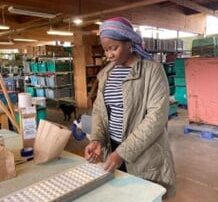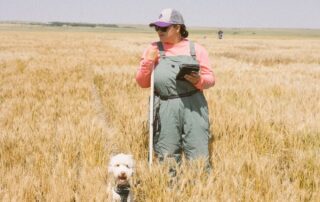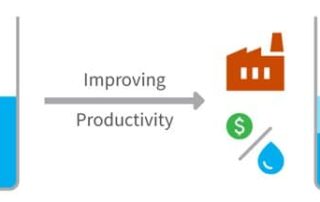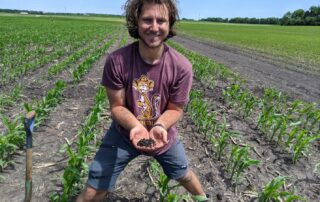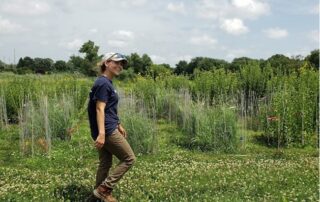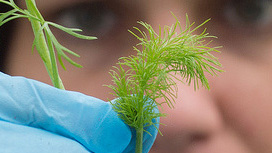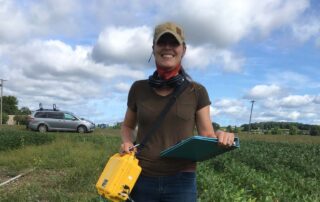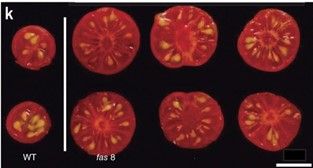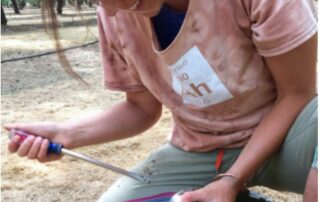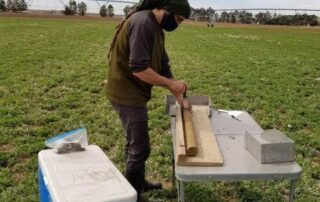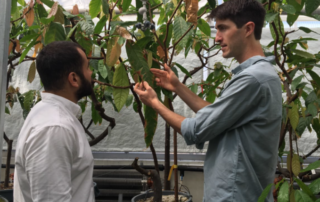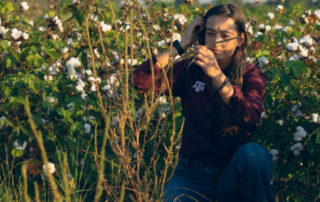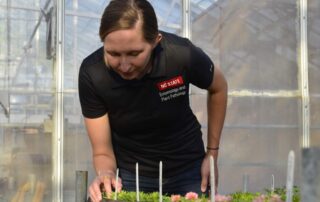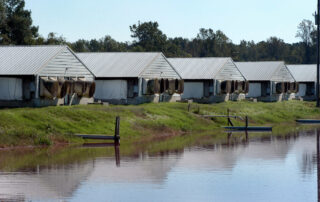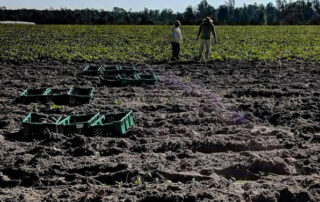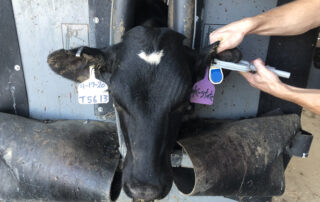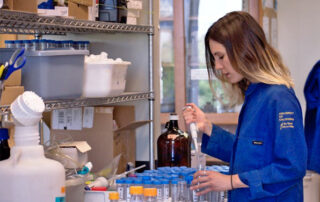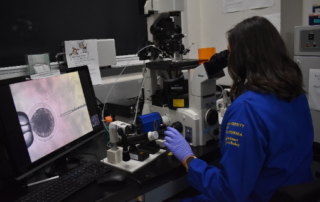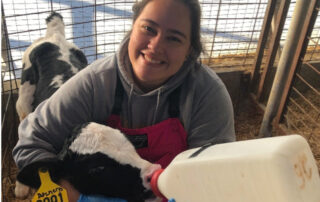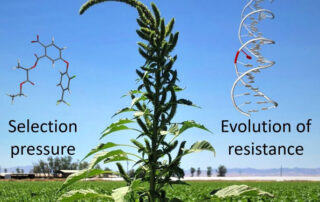From the FFAR Blog
Tackling Malnutrition with Biofortification
By Aichatou Djibo Waziri, 2021-2024 FFAR Fellow
Sometimes, minor details can have the biggest impact. For example, zinc is a mineral nutrient recommended in small proportions; just 12 to 15 milligrams per day suffices. Yet, a diet that’s deficient in zinc can cause a plethora of dysfunctions, including neural defects and delayed growth in infants. The solution to this challenge requires more than the development of supplements and fortified foods. Although the products from supplementation and fortification are relatively cheap in high-income countries, they are still unaffordable in many low-income countries. Additionally, the prevalence of malnutrition is further exacerbated in low-income countries due to their reliance on cereal grains, such as wheat and rice, that are inherently low in mineral nutrients.
Wheat: already delicious and now nutritious
By Addison Carroll, 2021-2024 FFAR Fellow
Strict dieters probably save the empty calories from pastas and breads for their ‘cheat’ days, but now wheat-based products can be both healthy and tasty. Historically, wheat production has primarily focused on yield – more wheat produced per hectare. Yet, the focus on increased production unintentionally resulted in reduced nutritional quality. Breads, noodles and the like are not considered to be particularly high in protein and micronutrients. Specifically, iron and zinc are the micronutrients that are most important to human health, yet are found in low quantities in wheat. Given growing threats to food and nutrition security in the face of population growth and a changing climate, scientists are tackling the challenge of producing wheat varieties that are both high yielding and rich in protein and nutritional quality.
Reducing water scarcity by improving water productivity in the United States
By Gambhir Lamsal, 2021-2024 FFAR Fellow
Water is a scarce resource utilized by farmers, cities and industries to advance their economic activity. As population increases and the effect of climate change intensifies, competition among multiple stakeholders will exert additional pressure on already over exploited resources. According to the US Government Accountability Office, four out of five states in the United States will face water scarcity somewhere in their state in the coming decade.
Manure – Waste or Resource?
By Manny Sabbagh, 2020-2023 FFAR Fellow
Many people view manure as just a pile of waste, yet this combination of feces, urine and bedding material is so much more than that. An inevitable byproduct of the livestock industry, manure can be an inexpensive tool to improve the soil and the plants we grow for food, fiber and fuel. With some supplementation from synthetic sources, manure can supply plants with the macro- and micro-nutrients needed for proper growth and production. My research as a Rockey FFAR Fellow at the University of Minnesota focuses on identifying optimal manure management strategies, with a specific focus on the use of cover crops, to help growers while also protecting the environment.
Dusting the Soil for Fungus-Prints: Spinach Seed Production and One of its Greatest Threats
By Alex Batson, 2019-2022 FFAR Fellow
Spinach, one of the most popular dark-green leafy vegetables in the American diet, is grown across the United States and the world. Yet spinach seed only can be produced in a few regions that share specific climatic conditions: summers characterized by long days, mild temperatures and low humidity with little rainfall. Consequently, the ideal climate in western Oregon and western Washington makes this the only spinach seed production region in the United States and the home of up to one-fifth of the global spinach seed supply.
A day on the Battlefield: Searching for Perennial defenses in wild places
By Kelsey Peterson, 2019-2022 FFAR Fellow
Punctuating the dust and dryness in my research plots is the sound of brown leaves scraping together – a sound typically heard in October when leaves begin to die on purpose as plants prepare for the winter. In July, however, the scrape of brown leaf on brown leaf is not good and the noise has nothing to do with the dry heat. Plants making this noise are infected – much like you would assume a person with a rattly cough is not well. Infections from pathogens – like rust – aptly named due to the amber, brown color of their reproductive pustules – push themselves into plant cells and leech on plant nutrients until the tissue dies.
Rockey FFAR Fellows Alumni Share Program Highlights
Established in 2018 by the Foundation for Food & Agriculture Research (FFAR) and North Carolina State University, the FFAR Fellows (recently renamed the Rockey FFAR Fellows), creates unparalleled opportunities for professional development and growth. As a trailblazing force in food and agriculture research, FFAR invests in scientific workforce development, including supporting the development of early-career scientists like the Rockey FFAR Fellows.
We spoke with several Rockey FFAR Fellow alumni who spoke from personal experience about the benefits of the program and how it has prepared them for professional success in the agriculture industry.
Can Adding Carbon to the Soil Help us Manage Weeds?
By Maria Gannett, 2019-2022 FFAR Fellow
Soil is alive with microorganisms and keeping the soil microbial community healthy is key to plant growth. But how exactly are soil microbes and plant growth related? And how might we use this knowledge to develop a useful weed management tool for growers? These are the fundamental questions my research is seeking to answer.
Gene Editing is a Real Solution for Climate Change
By Nicholas Karavolias, FFAR Fellow 2020-2023
As a plant biologist, I have continually been inspired by the work of peer researchers developing innovative solutions to the severe impacts of climate change in natural and agricultural environments. I have been especially inspired by the disruption that the new editing tool CRISPR/Cas has brought in fields ranging from human medicine to agriculture.
Taking Science Beyond the Bench: Critical Reflections for Change-Oriented Research
By Krista Marshall, 2019-2022 FFAR Fellow
The urgency of climate change mitigation and adaptation in agriculture coincides with a call for all of us to envision food systems that promote equity, justice and dignity for all people who produce, process, distribute and consume food. As scientists, we can play an important and collaborative role in generating solutions to these challenges. We should reflect a collective vision that represents a diverse range of stakeholders in our scientific work.
Soil is Not Dirt
By Aaron Prairie, 2020-2023 FFAR Fellow
Dirt is dead. Soil, on the other hand, is teaming with bacteria, fungi, algae and other tiny creatures that are the foundation of a symbiotic ecosystem. Like all living things, soil has health; defined as the continued capacity of soil to function as a diverse living ecosystem that sustains plants, animals and humans. This definition speaks to the importance of managing soils, so they are sustainable for future generations. Decades of conventional agriculture practices have damaged soil health resulting in the loss of soil biodiversity across the globe.
Heavy Metal and Chocolate: Not the Best Pairing
By Zachary Dashner, 2018-2021 FFAR Fellow
I study Theobroma cacao, the plant that produces a seed that, when fermented, becomes cocoa, the raw ingredient for one of the most popular treats in the world: chocolate. Unfortunately for cacao and chocolate lovers around the world, a rogue element is “passing” as iron and entering the plants’ root system, damaging its health and accumulating in the seeds. The culprit is cadmium, a non-essential heavy metal and an environmental toxin.
Herbicide-Resistant Weeds: Looking Below the Soil Surface
By Sarah Kezar, 2020-2023 FFAR Fellow
Farmers have been fighting weeds for millennia. While the number and efficacy of tools to combat weed pressures have vastly improved, weed resistance is a continuing problem for crop productivity and profitability. Even when weeds appear to be destroyed, their seeds linger, hidden in the soil seedbank. A seedbank is the living memory of resistant weed species and the source for future weed infestations. They are the most impactful robber of yields worldwide and particularly destructive for cotton, which is the focus of my research.
Seeding a Resilient Wheat Microbiome
By Lindsey Becker, 2018-2021 FFAR Fellow
Plants, like all living things, have co-evolved along with microbes. Plants are complex ecosystems for microbes, where every part of the plant and every surface can host and be shaped by a distinct community of bacteria, fungi, viruses and other microorganisms.
While we have known for centuries that these microbes exist, only in the last few decades have researchers been able to understand the microbial communities associated with plants by identifying key species and estimating their abundance. We now know that there are microbial communities, “microbiomes,” that are intimately linked to different species of plants.
Systems Thinking for Sustainable Manure Management
By Alison Deviney, 2018-2021 FFAR Fellow
Sustainability is a popular buzzword these days, but what does it really mean to be sustainable? That often depends on who you ask, particularly when it comes to the food animal industry. A livestock producer might think of maintaining economic viability in their farming operation, while their downwind neighbor may feel it is more about having fresh air to breathe and clean water to drink. Meanwhile, animal protein consumers generally focus on price, although their perceptions of quality or animal welfare could also impact purchasing choices. We can think of sustainability as a three-legged table where one leg represents the economy, one leg represents the environment and one leg represents society. If any of these legs fails – or alternatively, outsizes the others – the table falls over, unable to sustain its balance.
Climate Change Requires Novel Sweetpotato Breeding Approaches
By Camilo Parada Rojas, 2018-2021 FFAR Fellow
Fields of rotten sweetpotatoes are not an uncommon occurrence in growing regions that experience hurricanes. A week before harvest, heavy rain can sweep through the area, flooding fields and promoting infection by opportunistic soil pathogens. Higher humidity and temperatures can increase plant susceptibility to these pathogens. While hurricanes may be temporary, the looming threat of more intensified and frequent severe weather events is looming. These severe weather events can have a long-term impact on pathogen populations, plant susceptibility, farm productivity and profitability.
Fine-tuning photosynthesis
By Dhruv Patel, 2019-2022 FFAR Fellow
The dimmer switch is one of the most underrated inventions. Whether you are in the mood for a cozy setting or facing an action-packed day of Zoom meetings, with the dimmer switch you can adjust the light setting freely. Having a finer level of control can add something extra to your life. My research hopes to do the same, but by fine-tuning the genes in the foods we eat.
Do Cows Count Their Steps?
By Miriam Martin, 2019-2022 FFAR Fellow
Have you ever wondered what your dog or cat does when you’re not around? Our team at Kansas State University has the same question, but we wonder about cows. Unlike nanny-cams, which might work well to see if your new puppy is doing okay, cattle have evolved to stoically conceal when they aren’t feeling well in order to avoid predation. Precision animal monitoring technologies (think of a super-charged Fitbit) allow us to collect data on how animals are spending every second of their day. This unlocks a wealth of information about their behavior such as rumination and activity – yes, how many steps they are getting in – and can help us better monitor their health and well-being.
Trait Selection, the Human Microbiome and Health
By Nate Korth, 2019-2022 FFAR Fellow
The plant breeders and geneticists I know all make the same joke, “We breed for three traits: yield, yield and yield”. The seeming hyperbole of this statement fades when you consider the traits improved in crops over the last thousand years. While we focus on disease or drought resistance, the trait we’re really talking about is yield. The work conducted to improve crop yield is truly amazing and must be continued; however, in the pursuit of yield, many traits related to food nutrition have been overlooked.
Biochar, A Negative Emissions Technology
By Danielle Gelardi, 2019-2022 FFAR Fellow
Scientific and entrepreneurial interest in biochar has grown dramatically in the last 10 years. Between 2009 and 2019, the number of research publications mentioning biochar grew from 47 to 3,209, and US patent applications increased from one to 120. It is no surprise that this incredible rise occurred simultaneously with an evolving consciousness around climate change, and the urgency with which the United States must act to address it. In 2018, the International Panel on Climate Change officially listed biochar as a negative emissions technology, signaling that it may hold the key to some of our most pressing environmental challenges.
Surrogate sire research: Precision genetics to improve the sustainability of steak
By Maci Mueller, 2018-2021 FFAR Fellow
Beef cattle are raised all around the world. They are able to convert one of nature’s most abundant and raw resources – grass – into one of the most nutrient dense food sources available. However, some breeds of cattle can convert feed into beef more efficiently than others.
Dairy Cattle Metabolic Capacity: Milking It for all It’s Worth
By Linda Beckett, 2019-2022 FFAR Fellow
Remember back in elementary school when you learned that cows have four stomachs? Did anyone else think that was bizarre, yet cool at the same time? Given that humans are “one stomach” or monogastric mammals, most of my third-grade peers deemed all ruminant species to be “weird”. In fact, ruminant digestive systems are incredibly efficient and much less strange than one may think. My research aims to better understand how the ruminant digestive system, specifically the liver, contributes to energy production and amino acid metabolism. These processes are necessary for a healthy cow and successful farmer.
Climate change and Dairy Farming: Beating the Heat
By Ananda Fontoura, 2018-2021 FFAR Fellow
Imagine cattle living in Brazil, where temperatures range from 95 to 104 degrees Fahrenheit year-round, suffering from grave heat exposure. Fast shallow breathing, profusely sweating, drooling and panting as they overheat, walking less, looking for shade and drinking triple the amount of water. As a practicing veterinarian in Pará State, this was an unforgettable sight I couldn’t unsee.
Combating Herbicide Resistance
By Abby Barker, 2018-2021 FFAR Fellow
If you have ever cared for a garden or a lawn, you know weeds are pesky plants that show up every year without fail. While they come in many shapes and sizes, weeds generally share some characteristics: fast growth, competitive, high seed production, genetic diversity and that one thing that universally defines them— their presence where we don’t want them.

